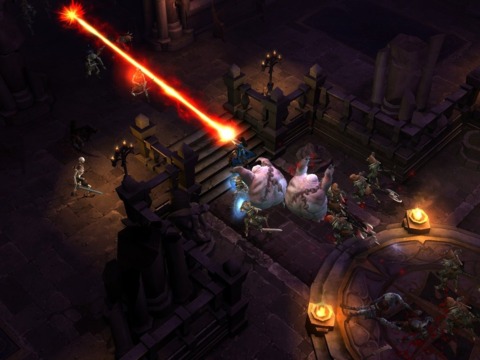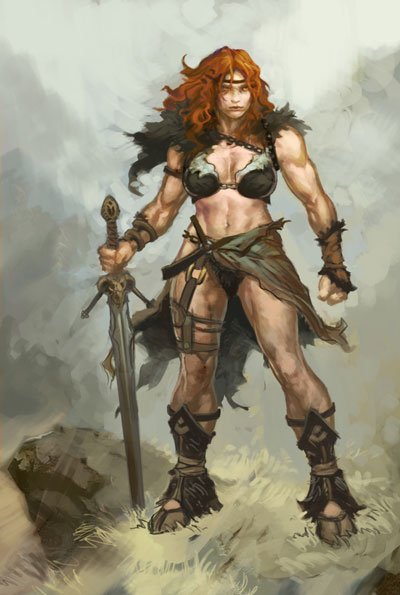BlizzCon 2008: Forging Diablo III's depths
Lead world designer Leonard Boyarsky and lead exterior environment artist Chris Donelson offer a tour through the art and lore of Blizzard's upcoming dungeon crawler.
ANAHEIM, Calif.--BlizzCon 2008 is nearly in the history books, but Blizzard isn't quite done talking about Diablo III, the third full installment in the game maker's seminal hack-and-slash dungeon-crawler franchise. Yesterday, Blizzard gave Diablo proselytes a look at the newly unveiled wizard class, a spiritual successor of sorts to the magic-infused sorceress seen in Diablo II. The developer of the day followed that session with a more in-depth look at Diablo III's design philosophy, promising to dish out more information on the direction of the game in the coming months and years.
Today, Blizzard's focus was on the lore and art design of Diablo III. The action role-playing game's art direction has been a sticking point ever since its debut at Blizzard's European Worldwide Invitational in June, with some fans taking strong exception to an art style they felt was "too cartoony" and similar to World of Warcraft. Though it was for causes seemingly unrelated, Blizzard changed up the game's art director in August, with then top man Brian Morrisroe resigning to form his own company.
For Blizzard's part, it has staunchly stood behind Diablo III's art design, a position that its employees held today. "'Stylized' does not mean 'cartoony,'" said lead exterior environment artist Chris Donelson. "That's not what we're going for with DIII...Our memory of Diablo and Diablo II was of a very dark and gray world, but looking back, we found a lot of areas with colorful environments."

Indeed, the broad color palette allowed for the Diablo III team to create a range of moods, continued Donelson, where players could be subjected to the juxtaposition of bright, sunny exteriors and dark, gritty dungeons. These contrasts played heavily into capturing the hallmark horror of the Diablo franchise. "Diablo is a horror game at its core, and we had to keep this as a strong emphasis," he said.
Capturing an epic feel with strong silhouettes has also been integral to Diablo III's art direction, according to Donelson. "Every day, we're surrounded by straight walls, straight lines, so adding interesting shapes puts us into a fantasy world," he explained. However, he said it's important that this fantasy world be grounded in reality.
Donelson then shifted to dynamic animations, saying it is this aspect of the art design that "brings life to an otherwise static scene." Here, he ran several videos displaying the destructible environments--such as a wall crumbling on top of enemies after its supports are knocked out--as well as a character's ability to quickly move about the screen, laying waste to traditional destructible items, such as barrels. "Plus, it's just plain fun to break things," he concluded.
Closing out his portion of the talk, Donelson emphasized that it is important that the art design augment, not trump, the core gameplay experience. "We can make beautiful art with tons of detail, but if you can't see what you're doing or the monsters onscreen, we aren't doing our job," he said. "Fun comes first, [and] art has to support that."
How the Diablo franchise's lore pertains to Diablo III was also addressed. Lead world designer Leonard Boyarsky--a veteran of the first Fallout and cofounder of defunct indie studio Troika--started off by introducing Diablo III's primary city, Caldeum. A trading hub, Caldeum has become the new capital city in the 20 years since the events in Diablo II. Boyarsky noted that one of the important questions to play out in the game will be how the migration of nobility and elite have affected the city.
Backstory will play a more important role in Diablo III than it has in previous installments in the franchise, said Boyarsky. He explained that the team wanted everywhere the player goes to have some significance and a rich narrative outside the actions of the player. As part of that effort, the lead world designer also introduced Skovos, a city that players won't actually be able to travel to but that will influence the events of the world just the same. Whereas Caldeum is strongly rooted in traditional society, Skovos is very much a culture built on myth and legend.

While Diablo III remains an action game at heart, Boyarsky said that providing a strong narrative is important because it gives context and depth to players' actions. This narrative will also change depending on which class the player chooses. Boyarsky played a sample clip of dialogue first as a female barbarian. Clearly addled by the eight-foot, muscle-bound woman in front of him, the non-player character adopts a tone of deference, treating the player with respect. The designer then played the exact same situation as a witch doctor, and the NPC adopted a far more hostile and condescending tone, ridiculing her for her odd appearance.
Boyarsky also emphasized that the story is of an "opt-in" nature, where players can choose to listen to a clip of dialogue in its entirety or simply catch bits and pieces to get a taste of the world. It could be important to pay attention to certain scripted events or other nodes, advised Boyarsky, as they may offer lessons on challenges the player will face in the future. As one example, Boyarsky rolled a clip of a trio of dark priests attempting to summon a demon and failing. Were the player to happen across a stronger covenant in the future, one advisable tactic would be to knock out a few of the summoners before the ceremony can be completed to thwart the demon from arising.
Got a news tip or want to contact us directly? Email news@gamespot.com
Join the conversation